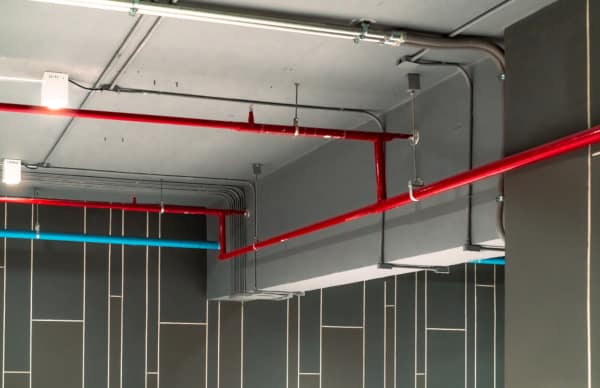In fire protection, sprinkler spacing is critical. Learn the rules for extended coverage sprinklers and obstructions.
Extended coverage sprinklers protect more area than standard spray sprinklers. This is useful in many applications, but it changes how they must be spaced out from other sprinklers, walls, and obstructions in the room.
NFPA 13: Standard for the Installation of Sprinkler Systems has rules for how fire sprinklers should be arranged in a room and outlines how much space the sprinklers cover and how far the sprinklers are from walls and other sprinklers. Getting sprinkler spacing and coverage right is fundamental and a core part of fire sprinkler system design and hydraulic calculations.
Check out our previous blogs for more information on hydraulic calculations for sprinkler systems and the process of sprinkler system design.
In the first part of this series, we looked at the basics of how extended coverage sprinklers should be spaced in a room, ensuring sprinklers aren’t too close to one another nor too far apart.
In this blog, we take a deeper dive into the rules for extended coverage sprinkler spacing and placement. Namely, we’re looking at obstructions. It would be easy to place sprinklers in an empty room with a perfectly smooth ceiling. But real buildings have joists, beams, storage racks, light fixtures, and more.
Below is a summary of the rules for navigating these obstacles using extended coverage sprinklers.
The basics of obstructions
Fire sprinklers need to develop an adequate spray pattern of water when they activate. Only by delivering the prescribed volume of water to their coverage area can fire sprinklers cool and wet surfaces to prevent the spread of a fire.
When obstructions are present, sprinklers must be arranged so they can throw water under and around the blockage. The 2019 edition of NFPA 13 says:
11.2.5.1.1 Sprinklers shall be located so as to minimize obstructions to discharge as defined in 11.2.5.2 and 11.2.5.3, or additional sprinklers shall be provided to ensure adequate coverage of the hazard.
Before we get into specific design requirements for obstructions, we should define the term. According to NFPA 13, an obstruction is any object or structure “at or below the level of sprinkler deflectors that affects the discharge pattern of a sprinkler (3.3.133).”
An obstruction is considered “continuous” if it affects two or more adjacent sprinklers. If it only affects one sprinkler, it is “noncontinuous.”
Obstructions and extended coverage sprinklers—the “four times rule”
Spacing fire sprinklers to avoid obstructions is all about leaving enough space. Sufficient distance between the sprinkler deflector and the obstruction allows the proper spray pattern to develop. For most obstructions, sprinkler designers turn to a couple of different versions of a pretty handy rule.
The “four times rule” for pendent and upright extended coverage sprinklers
The “four times rule” for the distance between obstructions and extended coverage sprinklers is a modified version of the “three times rule” for standard spray sprinklers. It applies to blockages that are no more than 18 inches below the sprinkler deflector:
11.2.5.2.1.3 Unless the requirements of 11.2.5.2.1.4 through 11.2.5.2.1.8 are met, sprinklers shall be positioned away from obstructions a minimum distance of four times the maximum dimension of the obstruction (e.g., truss webs and chords, pipe, columns, and fixtures) in accordance with Figure 11.2.5.2.1.3(a) and Figure 11.2.5.2.1.3(b).
It’s easier to understand what “The maximum dimension of the obstruction” means with an example. Say an obstruction to a fire sprinkler is a circular light fixture suspended from the ceiling. If the light fixture has a diameter of 6 inches and a thickness of 4 inches, the maximum dimension is 6 inches. The deflector of the extended coverage sprinkler therefore must be at least 24 inches (6 x 4 = 24) from this light fixture.
As is often the case with fire protection rules, there are a few caveats:
- For horizontally oriented obstructions like truss cords, the maximum distance required is 36 inches.
- For vertical obstructions like columns, use the second-largest dimension instead of the height of the obstruction.
This set of diagrams from NFPA 13 clarifies the meaning of the four times rule:

NFPA 13 also lists a few situations when designers do not have to follow the four-times rule:
- Flanking the obstruction—The rule doesn’t apply if a designer flanks the obstruction with sprinklers, as long as the distance from the sprinkler deflector to the centerline of the sprinkler is less than half the allowable distance between sprinklers (2.5.2.1.4).
- Halfway between narrow obstructions (2.5.2.1.5).
- Directly above narrow obstructions—the rule isn’t needed if you place a sprinkler directly above the centerline of a beam, truss, or bar joist, as long as the obstruction is not wider than 8 inches and the sprinkler is at least 6 inches from the obstruction (2.5.2.1.6)
- Ignoring sprinkler system piping—Designers do not need to consider sprinkler system piping less than 3 inches in diameter (2.5.2.1.7).
- Ignoring ceiling fans—You do not need to consider the blades of a ceiling fans as obstructions if their diameter is less than 60 inches and they are at least 50% open. The fan housing should be considered, however (2.5.2.1.9).
- If a designer chooses to (or must) follow more strict rules for horizontal and vertical offsets.
The “four-times rule” for extended coverage sidewall sprinklers
Arranging sidewall sprinklers when obstructions are present can be more difficult. Unlike upright and pendent sprinklers, sidewall sprinklers cannot be placed exactly where they are needed in the room—they are limited to the walls.
Nonetheless, the rules for spacing extended coverage sidewall sprinklers relative to obstructions are not too complicated. In fact, extended coverage sidewall sprinklers also use the four-times rule (11.3.6.2.1.3).
For sidewall sprinklers, the rule applies if the obstruction is within 18 inches below the sprinkler deflector. It says that the maximum distance from the sprinkler deflector to the obstruction is the smaller of four times the largest dimension of the obstruction or 36 inches.
As before:
- For vertical obstructions like columns, the second-largest dimension is used.
- Sprinkler system piping less than 3 inches in diameter can be ignored
- Ceiling fans less than 60″ in diameter can be ignored if their plan view is at least 50% open.
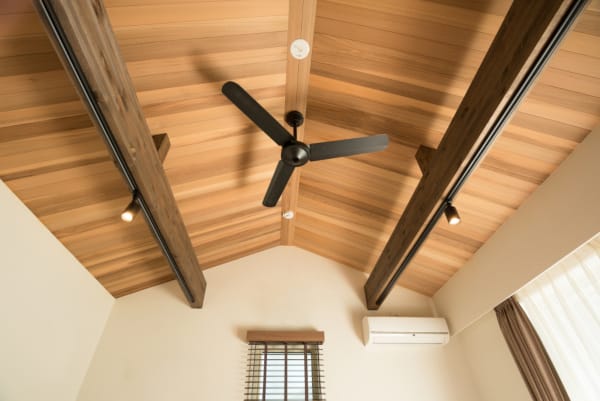
Horizontal and vertical spacing rules
For obstructions to upright and pendent extended coverage sprinklers, chapter 11 of NFPA 13 first directs the reader to the four-times rule and a rule for placing sprinklers under large obstructions.
But there is an alternative to measuring the linear distance from the sprinkler deflector to the obstruction. Instead, you may determine the horizontal and vertical offset needed for the sprinkler to throw water around the obstruction.
Employing these rules exempts designers from using the four-times rule. Additionally, designers must follow these rules when an obstruction is solid and continuous.
Offset sprinkler spacing for upright and pendent extended coverage sprinklers
Table 11.2.5.1.2 (reproduced below) allows the user to determine how high above the bottom of the obstruction to place a sprinkler based on the horizontal distance between the sprinkler and the obstruction. Figure 11.2.5.1.2(a) helps clarify this implementation.
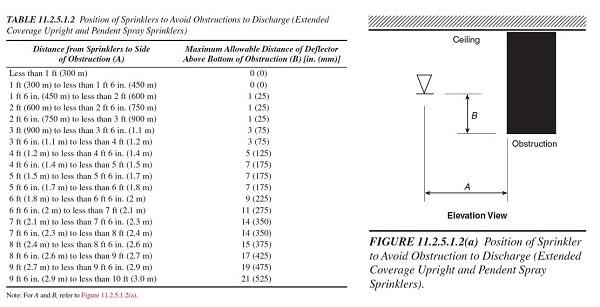
A variation of these rules applies to obstructions against the wall. It requires the designer to do some algebra, but the sprinkler spacing only applies if the obstruction is greater than 30 inches in width. Sprinkler spacing must satisfy this equation:
From Figure 11.2.5.1(b)
A >= (D – 8 in.) + B, where
A is the horizontal distance between the sprinkler deflector the obstruction
B is the vertical distance between the deflector and the bottom of the obstruction
D is the dimension of the obstruction
Figure 11.2.5.1(b) below provides some clarity on this rule. Remember, if the obstruction is less than 30 inches wide, you can ignore it and space the sprinkler from the wall beyond. This rule also applies to sidewall sprinklers (11.3.6.1.4).
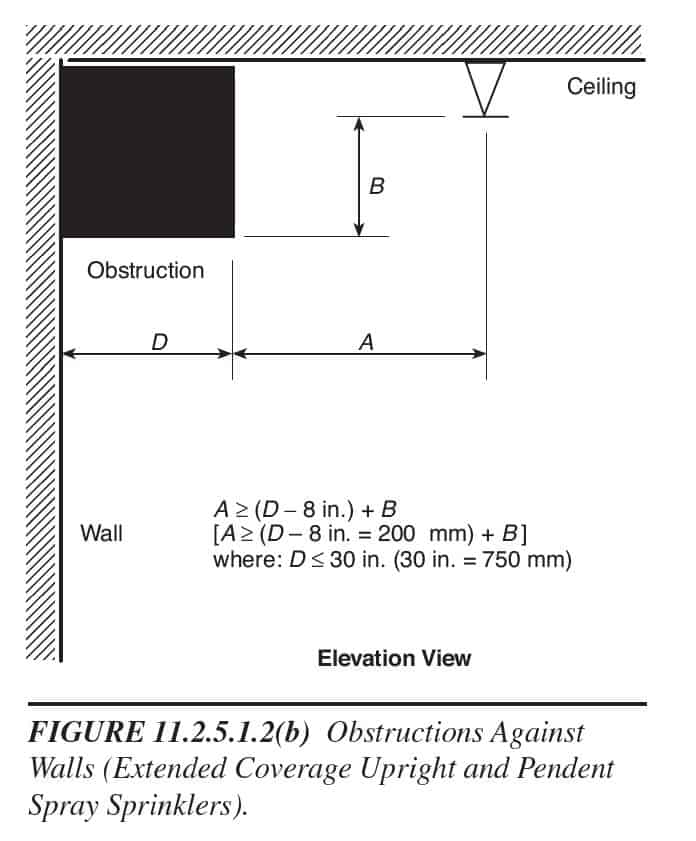
Offset and the 8-foot rule for sidewall extended coverage sprinklers
Similar offset rules may apply or can be employed with sidewall sprinklers. Designers are free to choose to use the 8-foot rule and the offset rules instead of the four-times rule (11.3.6.2.1.4). But there are also two situations when they must use the offset rules and the 8-foot rule.
First, if the obstruction is more than 18 inches below the deflector of the sprinkler, you should not use the four-times rule. Instead (11.3.6.1.2), a design must ensure that sprinklers are at least 8 feet from light fixtures or other similar obstructions and comply with the offset rules given in Table 11.3.6.1.3 and illustrated in Figure 11.3.1.6.3.
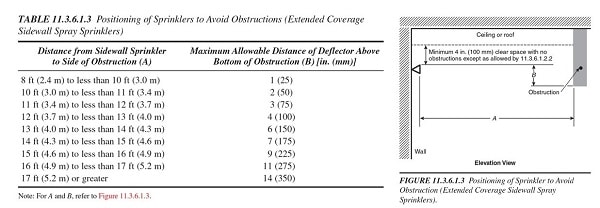
Second, designers must use the 8-foot rule and the vertical and horizontal spacing rules if the obstruction is solid and continuous.
A different set of offset values should be employed when the obstruction projects from the same wall as the sidewall sprinkler (11.3.6.1.4).
However, these calculations aren’t necessary if the projecting obstruction is less than 4 feet wide. In that case, a designer could flank the obstruction with sprinklers, provided that the centerline of the obstruction is within ½ the allowable distance between sprinklers from each deflector.
Large obstructions and extended coverage sprinkler spacing
The four-times rule, the various offset rules, and the other rules we’ve discussed so far have all been for obstructions that are comparatively small and relatively close to the sprinkler deflectors. But what about sprinkler spacing for very large obstructions that might be located further away?
Chapter 11 of NFPA 13 has—you guessed it—special rules for these scenarios. When an obstruction is more than 4 feet wide, extended coverage sprinklers cannot be arranged to throw water around the obstacle, no matter how far down the obstruction is. Flanking the obstruction will not solve the problem either. Instead, sprinklers must be installed underneath the obstruction (11.2.5.3.2). This applies to sidewall sprinklers, as well (11.3.6.3.2).
The only exception to this mandate is when obstructions do not exceed 4 feet and are lower than 18 inches from the sprinkler deflector. In this case, an adequate spray pattern will develop without placing sprinklers beneath the obstruction (11.2.5.3.2, 11.3.6.3).
Unfortunately, it’s possible for adjacent sprinklers to wet and cool sprinklers installed under obstructions, especially if the obstruction has open grating or is a round duct. And this spray may cool those lower sprinklers and delay activation.
To ensure the lower sprinklers operate as intended, the heads installed under open grating or round ducts should have the same kind of water shield (baffle) typically found on intermediate-level in-rack sprinklers (11.2.5.3.4-5).

Proper extended coverage sprinkler spacing avoids obstructions
Sprinklers must spray water over an adequate coverage area to control a fire. And this must happen whether a room is completely empty or full of water-blocking obstacles.
In this article, we’ve explained how NFPA 13 directs sprinkler system designers to space extended coverage fire sprinklers when obstructions are present. Note that extended coverage sprinklers throw water more horizontally, so they need more clearance to get around obstructions.
Turn to QRFS for your sprinkler installation needs. We stock a full line of commercial fire sprinklers—standard spray and extended coverage—from companies like Tyco, Victaulic, and Viking.
This blog was originally posted at blog.qrfs.com. If this article helped you, check us out at Facebook.com/QuickResponseFireSupply or on Twitter @QuickResponseFS.


